| | According to Statistics Canada, per capita consumption of fluid milk continues to fall. Per capita consumption has decreased by about 21.5 percent over a ten-year period, 1996 to 2015. However, flavoured milk consumption and cream consumption have increased significantly during the same period.
Canadian Per Capita Consumption of Dairy Milk:
A Comparison Between 1996 and 2015.
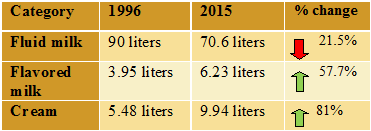
Source, Statistics Canada.
Consumption data for Alberta shows a different behavior. While liquid milk consumption fell by about the same percentage (22 per cent), there is no significant growth in chocolate and other flavored milk. Unlike the Canadian average, cream consumption has declined by about 5.6 per cent during the ten-year period.
Per Capita Milk Consumption, Canada (1996 to 2015)
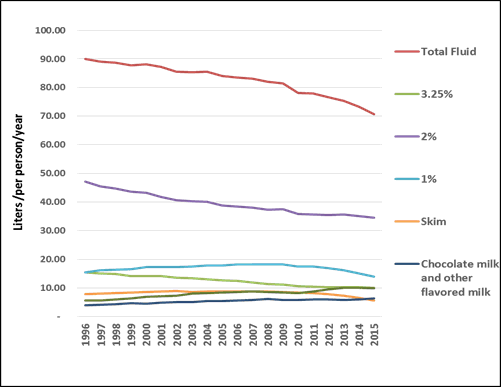
Source: Statistics Canada
Calculation done by AAFC-AID, Market Information Section
The popularity of specialty coffee shops in Canada is one of the key forces behind the growing per capita consumption of cream. The decline in demand for dairy milk could be attributed to three primary factors:
- Increasing demand for “solid” dairy products options;
- Changing demographics and consumer perceptions;
- Competition from dairy milk alternative.
However, according to Canadian Dairy Information Centre, demand for organic milk and goat milk is increasing in Canada. Although consumer demand data is not available for these categories, production of certified organic milk has been showing an increase over the years (Canadian Dairy Information Centre, http://www.dairyinfo.gc.ca/pdf/org-bio_can_e.pdf
(1) Increasing demand for “solid” dairy products options
Sales data from Nielsen Canada show that during 2015, Canadian milk sales have declined by more than $25 million. This is about a two per cent reduction in sales compared to 2014. Yogurt and cheese sales rose by about four per cent during the same period. The uptrend for yogurt and cheese is more likely the result of current snacking trends. Both cheese and yogurt were listed as top snacking categories for Canadians in a recent global survey report on snacking trends.
Changes in Retail Sales Volumes from 2014 to 2015, Canada
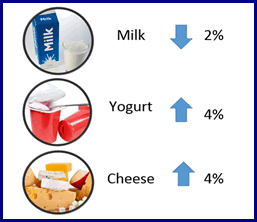
Even though sales in the overall category are declining, milk is still the largest dairy segment in Canada. When it comes to growth in the Canadian milk market – size matters. For example, sales of single-serve 250 ml milk containers grew 22 per cent over the last year, while sales of bottles of one liter or more declined.
While white milk is struggling, other milk categories such as chocolate milk and flavored milk (especially banana flavored) are holding their shares. Their sales dollars have increased by one per cent and four per cent respectively in 2015.
In Alberta, liquid milk retail sales values remained steady from 2013 to 2014 at $ 323 million. However, during the same period, yogurt and natural cheese sales increased by one per cent and six per cent, respectively.
(2) Changing demographics and consumer perceptions
Among the many factors that contribute to declining milk consumption, aging population is believed to be one major factor. According to Statistics Canada1, older demographics drink less milk.
The fact that Canada has a higher percentage of the population in the older demographic segments (figure below) provides further evidence to support this assertion.
Profile of Generations in Alberta and Canada, 2001
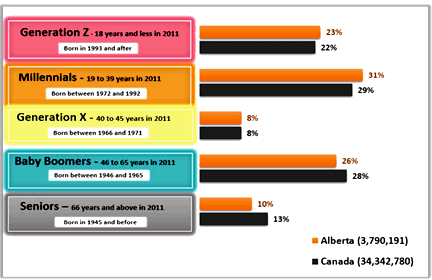
Source: Statistics Canada
Perception wise, many people associate milk only with calcium with no other nutritional benefit. Sometimes milk is viewed as a breakfast accompaniment to cereal and tea and not as a standalone beverage.
Lactose intolerance, allergies, veganism, the paleo diet2 and general health and wellbeing trends have also been identified as reasons for lower consumption of milk among Canadians.
Some sources3 have mentioned that a lack of interesting flavours and portability are among the reasons that the younger generation is shying away from milk.
(3) Competition from dairy milk alternatives
The demand for dairy milk alternatives is on the rise. Milk alternatives are liquids that replace milk in a diet or in a recipe. They are consumed for many different reasons, including those mentioned above. The milk-alternatives industry can be classified into following the types: soy milk, almond milk, rice milk and others such as coconut milk, oat milk, hemp milk and hazelnut milk.
According to Nielsen Home Scan data, Canadian sales of almond milk have tripled over the past two years to January 2016, while rice milk has grown by six per cent. However, soy milk sales have declined by seven per cent over the same period. Alberta retail grocery sales data shows that the non-dairy milk alternative category had a whopping 225 percent growth in sales from 2011 to 2014. A breakdown of the different milk alternatives was unavailable for this data set.
Retail Sales- Rice and Non-Dairy Alternatives, Alberta (2011 to 2014)
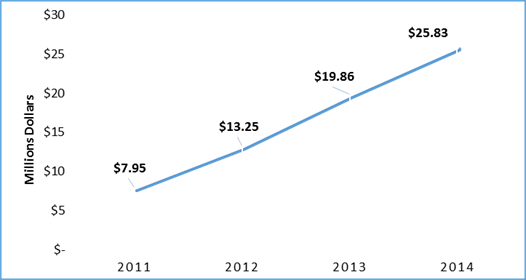
Source: Nielsen MarketTrack; ALBERTA ALL CHANNELS - 52 Weeks to Period Ending Date ending
Dec 13 14, All By Key Account ; TOTAL ALL CATEGORIES; Volume Basis = Sales Units
The story is similar in the US and in the global market. According to Nielsen, almond milk is now America’s favorite milk substitute, boasting sales growth of 250 per cent over the five years period covering 2010 to 2015. During the same period, the dairy milk market shrunk by more than one billion US dollars.
While almond milk still accounts for just a fraction of the total milk market (about five per cent), it brings in more than twice the revenue of the other milk substitutes combined.
Sale of Almond Milk and Milk Substitutes in US, 2015
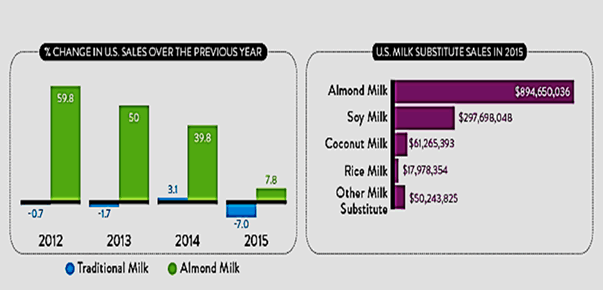
Source: Nielsen, AOD 52 weeks ending 12/26/15
BCC Research, a US based research company, reports that the global market for milk alternatives reached $5.8 billion US in 2014 and is expected to grow to about $10.9 billion US in 2019. The Asia-Pacific held the highest market share (50.4 per cent) of the global milk alternative market in 2013. The North American market held the second-largest share (30.6 per cent), with Europe, Middle East and Africa markets accounting for remaining 19 per cent of the market share.
The increasing trend of almond milk sales can be attributed to :
- Consumer valuing “back-to-basic” food with attributes such as “all-natural”, “no artificial color or flavors” and “made from vegetables or fruits” (Nielsen’s 2015, Global Health and Wellness survey).
- Ingredients sourced sustainably are very important in consumers’ purchase decisions. This attribute is very important for 40 per cent of Generation Z, followed by 38 per cent of Millennial, 34 per cent of Generation X and 21 per cent of boomers and seniors.
- Dietary restrictions like lactose intolerance with dairy milk and concerns over hormones (plant estrogen or iso-flavones) found in soy milk.
Concluding Remarks
,
- Fluid milk consumption is decreasing in Canada. However, cream consumption and “solid” options such as cheese and yogurt consumption are increasing.
- The reason for the ‘solid’ category growth is the increasing snack food trend including cheese and yogurt.
- A small increase in sales of Canadian flavored milk, organic milk and goat milk has occurred in recent years.
- Consumer demand for milk alternatives is increasing significantly, especially for almond milk.
- Demographic changes, lactose intolerance, allergies, veganism, the paleo diet, general health and wellbeing and changing consumer perceptions are identified as the reasons behind the declining consumption of dairy milk.
Sources:
.

|
|